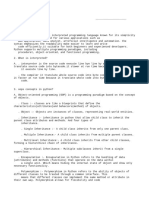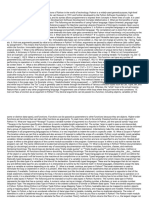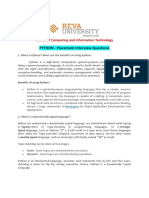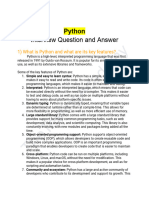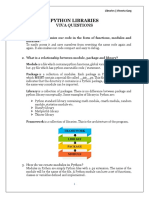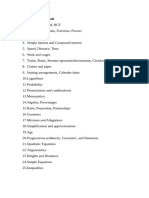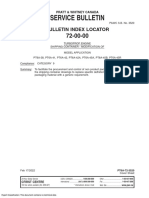Installing Anaconda/Gurobi: Python - M Pip Install Gurobipy Conda Install - C Gurobi Gurobi 9.5.0
Installing Anaconda/Gurobi: Python - M Pip Install Gurobipy Conda Install - C Gurobi Gurobi 9.5.0
Uploaded by
Riya SharmaCopyright:
Available Formats
Installing Anaconda/Gurobi: Python - M Pip Install Gurobipy Conda Install - C Gurobi Gurobi 9.5.0
Installing Anaconda/Gurobi: Python - M Pip Install Gurobipy Conda Install - C Gurobi Gurobi 9.5.0
Uploaded by
Riya SharmaOriginal Title
Copyright
Available Formats
Share this document
Did you find this document useful?
Is this content inappropriate?
Copyright:
Available Formats
Installing Anaconda/Gurobi: Python - M Pip Install Gurobipy Conda Install - C Gurobi Gurobi 9.5.0
Installing Anaconda/Gurobi: Python - M Pip Install Gurobipy Conda Install - C Gurobi Gurobi 9.5.0
Uploaded by
Riya SharmaCopyright:
Available Formats
Installing Anaconda/Gurobi
1. Install Anaconda:
Download/Install Anaconda: https://docs.anaconda.com/anaconda/install/
Open Anaconda Navigator
Launch Jupiter Notebook
2. Download/Install Gurobi
https://www.gurobi.com/
3. Download the Gurobi license.
Go to:
https://www.gurobi.com/academia/academic-program-and-licenses/
Register for an academic account in order to get the license.
4. Setup Gurobi license
5. “Install Gurobi into Anaconda
https://www.gurobi.com/gurobi-and-anaconda-for-windows/
6. Install gurobipy libarary
python -m pip install gurobipy
conda install -c gurobi gurobi=9.5.0
Working With Jupiter Notbook
7. Download the Repository” of problems from Introduction to Mathematical Optimization
Modeling Page:
https://colab.research.google.com/github/Gurobi/modeling-examples/blob/master/
intro_to_modeling/introduction_to_modeling_gcl.ipynb
8. I will demonstrate the “Agricultural Pricing” problem.
a. Solve the problem via Jupiter Notbook
b. Solve the problem via Spyder
Gurobi & Python Resources
1. Gurobi Optimizer Beginner’s Guide
Let us work together the example on page 75.
Let us work together the example on page 80.
Let us work together the example on page 84.
2. Python Beginner’s guide: https://wiki.python.org/moin/BeginnersGuide
3. Documents related to python: https://docs.python.org/3/tutorial/
a. Data structures: Section 3.1.3 & Section 5
Data Structures:
Lists: can be written as a list of comma-separated values (items) between square brackets. Lists
might contain items of different types, but usually the items all have the same type.
Tuples are crucial to providing efficient and convenient access to Gurobi decision variables in
Gurobi Python programs. Lists and tuples are both just ordered collections of Python objects. A
list is created and displayed as a comma-separated list of member objects, enclosed in square
brackets. A tuple is similar, except that the member objects are enclosed in parenthesis. For
example, [1, 2, 3] is a list, while (1, 2, 3) is a tuple.
A tuple is immutable, meaning that you can’t modify it once it has been created. By contrast, you
can add new members to a list, remove members, change existing members, etc. This immutable
property allows you to use tuples as indices for dictionaries.
Sets: A set is an unordered collection with no duplicate elements. Set objects also support
mathematical operations like union, intersection, difference, and symmetric difference.
Dictionaries are sometimes found in other languages as “associative memories” or “associative
arrays”. Unlike sequences, which are indexed by a range of numbers, dictionaries are indexed
by keys, which can be any immutable type; strings and numbers can always be keys.
A Python dictionary allows you to map arbitrary key values to pieces of data. It is best to think of
a dictionary as a set of key: value pairs, with the requirement that the keys are unique (within one
dictionary). A pair of braces creates an empty dictionary: {}. Placing a comma-separated list of
key: value pairs within the braces adds initial key: value pairs to the dictionary; this is also the
way dictionaries are written on output.
Gurobi included a utility routine in the Gurobi Python interface that simplifies dictionary
initialization for a case that arises frequently in mathematical modeling. The multidict function
allows you to initialize one or more dictionaries in a single statement. The function takes a
dictionary as its argument, where the value associated with each key is a list of length n. The
function splits these lists into individual entries, creating n separate dictionaries. The function
returns a list. The first result is the list of shared key values, followed by the n individual
dictionaries:
You might also like
- Ams4945h 2020Document10 pagesAms4945h 2020BauyrzhanNo ratings yet
- Method Statement: For Internal & External Plastering Works: Rev. Date Prepared by Checked & Approved byDocument9 pagesMethod Statement: For Internal & External Plastering Works: Rev. Date Prepared by Checked & Approved byEyutt Hghgh100% (1)
- ETech - Q1 - M4 PDFDocument33 pagesETech - Q1 - M4 PDFpaul rick75% (16)
- Unit 4Document15 pagesUnit 4berawor167No ratings yet
- Python LearningDocument33 pagesPython Learningalvii.kNo ratings yet
- PythonDocument12 pagesPythonRakshitNo ratings yet
- Programming Notes (Pythun) Chapter WiseDocument41 pagesProgramming Notes (Pythun) Chapter Wisemuhammad afzzalNo ratings yet
- Python Model Paper 1Document28 pagesPython Model Paper 1SAMANVITA RdNo ratings yet
- Python Q - 2Document14 pagesPython Q - 2Nilanjana DasNo ratings yet
- Python TheoryDocument8 pagesPython Theory1968fathimapaNo ratings yet
- Python Viva Q-ANSDocument8 pagesPython Viva Q-ANSMit ShahNo ratings yet
- Python Interview Questions FreshersDocument5 pagesPython Interview Questions FreshersSaravana KohliNo ratings yet
- 1Document7 pages1Santosh GobheNo ratings yet
- DNN 8 Ziku HVDocument5 pagesDNN 8 Ziku HVSantosh GobheNo ratings yet
- Python Interview QuestionsDocument16 pagesPython Interview Questionswardah.2944No ratings yet
- Why To Choose Python? What Can We Do With Python?Document27 pagesWhy To Choose Python? What Can We Do With Python?RUTUJA LOKHANDENo ratings yet
- LibO Primitives V0ad Without ClassesDocument174 pagesLibO Primitives V0ad Without Classesmusah ayubaNo ratings yet
- Data Science Assignment 1Document20 pagesData Science Assignment 1Xhy KatNo ratings yet
- Intro To Python For BeginnersDocument7 pagesIntro To Python For BeginnersjsilvaeNo ratings yet
- Python Placement QuesDocument45 pagesPython Placement QuesParamesH GNo ratings yet
- Unit-Ii-Introduction To PythonDocument25 pagesUnit-Ii-Introduction To PythonBabu INo ratings yet
- Python Tutorial For Beginners (Ai Notes)Document38 pagesPython Tutorial For Beginners (Ai Notes)Vansh Rojivadia (Vansh)No ratings yet
- NLP Python Answer FinalsDocument11 pagesNLP Python Answer FinalsSpam TargetNo ratings yet
- Python SS One ContentDocument60 pagesPython SS One ContentPebbles TechnologiesNo ratings yet
- Python ProgrammingDocument11 pagesPython ProgrammingSrinivasa RaoNo ratings yet
- Learn PythonDocument11 pagesLearn PythonMaria Rizza LuchavezNo ratings yet
- Viva Question AnsDocument8 pagesViva Question AnsTanmay MhatreNo ratings yet
- Python CCE - II by Atul Sadiwal?Document7 pagesPython CCE - II by Atul Sadiwal?Harsha ChoudharyNo ratings yet
- How To Use Python With Mathematics For Data ScienceDocument16 pagesHow To Use Python With Mathematics For Data ScienceRhoda Grace Agustin IlisanNo ratings yet
- Question AnswersDocument8 pagesQuestion AnswersArtifical SmartNo ratings yet
- Python Interview QnADocument63 pagesPython Interview QnAdeepakguptarkshNo ratings yet
- 100 Most Asked Python Interview QnADocument15 pages100 Most Asked Python Interview QnAAnirudh ANo ratings yet
- 04 Fundamental Jul 24Document131 pages04 Fundamental Jul 24gosix63084No ratings yet
- Introduction To PythonDocument13 pagesIntroduction To PythonFaraz awanNo ratings yet
- Q1.What Is Python? Can You Enlist The Benefits of Using Python?Document4 pagesQ1.What Is Python? Can You Enlist The Benefits of Using Python?Adnan AslamNo ratings yet
- Python PPT 03Document54 pagesPython PPT 03supriya mandalNo ratings yet
- Aakashns - Python-Variables-And-Data-Types - JovianDocument37 pagesAakashns - Python-Variables-And-Data-Types - JovianAbdul QadeerNo ratings yet
- Python LibrariesDocument2 pagesPython LibrarieschiragNo ratings yet
- Bioinformatics 081144Document22 pagesBioinformatics 081144Arfa AhmadNo ratings yet
- Theory Python QuestionsDocument6 pagesTheory Python QuestionsPurvi ChaurasiaNo ratings yet
- Aptitude TopicsDocument12 pagesAptitude TopicsAshie AishuNo ratings yet
- Interview Question PythonDocument14 pagesInterview Question Pythonkumarjit paitNo ratings yet
- Top 20 Go Programming Interview QuestionsDocument4 pagesTop 20 Go Programming Interview QuestionsReinNo ratings yet
- A Crash Course in Python For Scientists PDFDocument55 pagesA Crash Course in Python For Scientists PDFJianNo ratings yet
- 5th Unit Question BankDocument7 pages5th Unit Question BankHarish SNo ratings yet
- Chapter 1 - Introduction To Python ProgrammingDocument18 pagesChapter 1 - Introduction To Python ProgrammingChenky DalanonNo ratings yet
- 1) What Is Python?: List TupleDocument9 pages1) What Is Python?: List TuplexcsplcareersNo ratings yet
- Python Assignment 3Document8 pagesPython Assignment 3eshanpadhiar3No ratings yet
- Python Interview QuestionsDocument54 pagesPython Interview Questionsdorian451No ratings yet
- PythonDocument3 pagesPythonShweta SainiNo ratings yet
- Python Interview QuestionsDocument27 pagesPython Interview QuestionsArsalanNo ratings yet
- Python Qbsol BypsDocument49 pagesPython Qbsol BypsVidnyan SalunkeNo ratings yet
- Python Interview Questions and AnswersDocument15 pagesPython Interview Questions and Answerssupercool.iman1998No ratings yet
- PYTHON DATA SCIENCE FOR BEGINNERS: Unlock the Power of Data Science with Python and Start Your Journey as a Beginner (2023 Crash Course)From EverandPYTHON DATA SCIENCE FOR BEGINNERS: Unlock the Power of Data Science with Python and Start Your Journey as a Beginner (2023 Crash Course)No ratings yet
- IZETAM TECHNOLOGIES - Interview Questions of Python For 2 Years ExperiencedDocument9 pagesIZETAM TECHNOLOGIES - Interview Questions of Python For 2 Years ExperiencedPreethiNo ratings yet
- Python CodingDocument61 pagesPython Coding4069-Sam ChristopherNo ratings yet
- My Assignment - 081404Document22 pagesMy Assignment - 081404Arfa AhmadNo ratings yet
- Python Interview QuestionsDocument34 pagesPython Interview QuestionsDavid MullangiNo ratings yet
- 13 - Data Structures and Algorithms Stacks, Queues, and GenericsDocument3 pages13 - Data Structures and Algorithms Stacks, Queues, and Genericsafghkldd45No ratings yet
- Fullstack Development - Module 2Document94 pagesFullstack Development - Module 2swarajbharathpNo ratings yet
- OOP Is A Design Philosophy. It Stands For Object Oriented Programming. Object-OrientedDocument37 pagesOOP Is A Design Philosophy. It Stands For Object Oriented Programming. Object-OrientedRaja SekaranNo ratings yet
- Cole CVDocument28 pagesCole CVRiya SharmaNo ratings yet
- Ineg4163 Homework (Classification and Regression Tree) : Load ("Path To The Data On Your Computer/Data3.Rdata")Document3 pagesIneg4163 Homework (Classification and Regression Tree) : Load ("Path To The Data On Your Computer/Data3.Rdata")Riya SharmaNo ratings yet
- Exam May27 2011Document1 pageExam May27 2011Riya SharmaNo ratings yet
- Conicsection 155Document17 pagesConicsection 155Riya SharmaNo ratings yet
- Universal Engineering & Science College Chakupat-Lalitpur Class Routine II SemesterDocument3 pagesUniversal Engineering & Science College Chakupat-Lalitpur Class Routine II SemesterRiya SharmaNo ratings yet
- User Manual DVP-14SSDocument440 pagesUser Manual DVP-14SSIvan BerlotNo ratings yet
- Action ResearchDocument11 pagesAction ResearchLhen Dimla - GarciaNo ratings yet
- Portfolio Advance 11Document17 pagesPortfolio Advance 11Dafner JanethNo ratings yet
- Poz. 4 - F27HC 85 E 6Document2 pagesPoz. 4 - F27HC 85 E 6mmprojectexpertbackupNo ratings yet
- Stability Analysis For A Class of Takagi-Sugeno Fuzzy Control SystemsDocument12 pagesStability Analysis For A Class of Takagi-Sugeno Fuzzy Control SystemsBộ Môn DieuKhienhocNo ratings yet
- IPPTChap023, Theory of ConstraintsDocument32 pagesIPPTChap023, Theory of ConstraintsEugenie FebbyNo ratings yet
- 2022 Ioniq 5 Owners ManualDocument663 pages2022 Ioniq 5 Owners ManualgrooveinNo ratings yet
- TPMS (Tire Pressure Monitoring System) TSBDocument25 pagesTPMS (Tire Pressure Monitoring System) TSBlooseshengjiNo ratings yet
- KS-VSP Operation ManualDocument16 pagesKS-VSP Operation ManualRinto SilalahiNo ratings yet
- MSME - Pratham Heat TreatmentDocument2 pagesMSME - Pratham Heat TreatmentprathamheattreatmentNo ratings yet
- Information Technology s7 & s8Document317 pagesInformation Technology s7 & s8AKHIL HAKKIMNo ratings yet
- Counter Flow RegenerationDocument8 pagesCounter Flow Regenerationvel muruganNo ratings yet
- PRATT & WHITNEY SB 3520 Shipping Container ModificationDocument6 pagesPRATT & WHITNEY SB 3520 Shipping Container ModificationBrunoNo ratings yet
- Naval Vessels LightsDocument1 pageNaval Vessels LightsAmenNo ratings yet
- 2019 HSB IR Thermography Sample ReportDocument17 pages2019 HSB IR Thermography Sample ReportMdosmNo ratings yet
- Complete Checklist For Manual Upgrades To Non-CDB Oracle Database 12c Release 2 (12.2) (Doc ID 2173141.1)Document11 pagesComplete Checklist For Manual Upgrades To Non-CDB Oracle Database 12c Release 2 (12.2) (Doc ID 2173141.1)elcaso34No ratings yet
- Atex Reference Guide PDFDocument2 pagesAtex Reference Guide PDFSrinivas KosuruNo ratings yet
- IBM - The Next-Generation Data CenterDocument16 pagesIBM - The Next-Generation Data CenterHoang LeNo ratings yet
- Overview of The Encryption Features For VSP F Series and VSP G SeriesDocument12 pagesOverview of The Encryption Features For VSP F Series and VSP G SeriesHtc HtcNo ratings yet
- Softimage XSIDocument202 pagesSoftimage XSILloyd DelphNo ratings yet
- X Ride Part CatalogueDocument46 pagesX Ride Part CatalogueMahful Irvay MukhlisNo ratings yet
- MBI5041 MacroblockDocument23 pagesMBI5041 MacroblockCristhianNo ratings yet
- Number SystemDocument23 pagesNumber Systemmark porralNo ratings yet
- Mini Project SynopsisDocument7 pagesMini Project Synopsis4AI17CS100- Spoorthi K SNo ratings yet
- Social EngineeringDocument4 pagesSocial EngineeringKalNo ratings yet
- More Local Lit!!!!Document4 pagesMore Local Lit!!!!Ayumi SatoNo ratings yet
- Fosroc Proofex Engage BrochureDocument9 pagesFosroc Proofex Engage BrochurecsaNo ratings yet









